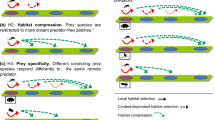Abstract
Conspecific attraction is the preferential settlement into habitat patches with conspecifics. To be a good proximate strategy, fitness gains from settling with conspecifics must outweigh the costs of higher conspecific densities, such as intraspecific competition. Two types of benefits have been proposed to explain conspecific attraction: Allee effects (i.e., positive density dependence) and conspecific cueing (using conspecifics as an indicator of habitat quality). I present empirical evidence for conspecific attraction in the settlement of the porcelain crab, Petrolisthes cinctipes Randall (Anomura: Porcellanidae). Previous work demonstrated that P. cinctipes experiences strong intraspecific competition and that both Allee effects and conspecific cueing are present in P. cinctipes life-history. I developed an empirically-based fitness model of the costs and benefits of settling with conspecifics. Based on this model, I simulated optimal settlement to habitat patches that varied in conspecific density and habitat quality, where the correlation between density and habitat quality determined the level of conspecific cueing. I tested whether Allee effects alone, conspecific cueing alone, or Allee effects and conspecific cueing together could provide an ultimate explanation for the proximate settlement behavior of P. cinctipes. The settlement simulation was consistent with empirical settlement only when Allee effects and conspecific cueing were both included. Three life-history features are critical to this conclusion: (1) fitness is maximized at intermediate density, (2) fitness depends on the decisions of previous settlers, and (3) conspecific density provides good information about habitat quality. The quality of information garnered from conspecifics determines whether conspecific attraction is a good proximate strategy for settlement. I present a graphical illustration demonstrating how Allee effects and conspecific cueing work together to influence fitness, providing a conceptual framework for other systems.





Similar content being viewed by others
References
Akins LJ (2003) The relative effects of top-down and bottom-up processes and abiotic factors on the abundance of shore crabs around a headland. Masters thesis, University of California, Calif.
Baltz AP, Clark AB (1999) Does conspecific attraction affect nest choice in budgerigars (Melopsittacus undulatus: Psittacidae: Aves)? Ethology 105:583–594
Bertness MD (1989) Intraspecific competition and facilitation in a northern acorn barnacle population. Ecology 70:257–268
Bertness MD, Grosholz E (1985) Population dynamics of the ribbed mussel, Geukensia demissa: the costs and benefits of an aggregated distribution. Oecologia 67:192–204
Brown CR, Brown MB, Danchin E (2000) Breeding habitat selection in cliff swallows: the effect of conspecific reproductive success on colony choice. J Anim Ecol 69:133–142
Buckley NJ (1997) Spatial-concentration effects and the importance of local enhancement in the evolution of colonial breeding in seabirds. Am Nat 149:1091–1112
Burke RD (1986) Pheromones and the gregarious settlement of marine invertebrate larvae. Bull Mar Sci 39:323–331
Chesson P (2000) General theory of competitive coexistence in spatially-varying environments. Theor Popul Biol 58:211–237
Clark CW, Mangel M (1984) Foraging and flocking strategies: information in an uncertain environment. Am Nat 123:626–641
Courchamp F, Clutton-Brock T, Grenfell B (1999) Inverse density-dependence and the allee effect. Trends Ecol Evol 14:405–410
Danchin E, Boulinier T, Massot M (1998) Conspecific reproductive success and breeding habitat selection: implications for the study of coloniality. Ecology 79:2415–2428
Danchin E, Heg D, Doligez B (2001) Public information and breeding habitat selection. In: Clobert J, Danchin E, Dhondt AA, Nichols JD (eds) Dispersal. Oxford University Press, Oxford
Dobson AJ (2002) An introduction to generalized linear models. Chapmal & Hall, London
Doligez B, Danchin E, Clobert J (2002) Public information and breeding habitat selection in a wild bird population. Science 297:1168–1170
Doligez B, Cadet C, Danchin E, Boulinier T (2003) When to use public information for breeding habitat selection? The role of environmental predictability and density dependence. Anim Behav 66:973–988
Doligez B, Part T, Danchin E (2004) Prospecting in the collared flycatcher: gathering public information for future breeding habitat selection? Anim Behav 67:457–466
Donahue MJ (2003) The interaction of dispersal and density dependence: resource variation, competition, and gregarious settlement. PhD dissertation, University of California, Calif.
Donahue MJ (2004) Size-dependent competition in a gregarious porcelain crab, Petrolisthes cinctipes Randall (Anomura:Porcellanidae). Mar Ecol Prog Ser 267:195–207
Finelli CM, Pentcheff ND, Zimmer RK, Wethey DS (2000) Physical constraints on ecological processes: a field test of odor-mediated foraging. Ecology 81:784–797
Fitzgerald TP, Forward RB, Tankersley RA (1998) Metamorphosis of the estuarine crab Rhithropanopeus harrisii: effect of water type and adult odor. Mar Ecol Prog Ser 165:217–223
Forward RB, Jr, Tankersley RA, Rittschof D (2001) Cues for metamorphosis of brachyuran crabs: an overview. Am Zool 41:1108–1122
Genest C, MacKay J (1986) The joy of copulas: bivariate distributions with uniform marginals. Am Stat 40:280–283
Gosselin LA, Qian PE (1997) Juvenile mortality in benthic marine invertebrates. Mar Ecol Prog Ser 146:265–282
Greene CM (2003) Habitat selection reduces extinction of populations subject to allee effects. Theor Popul Biol 64:1–10
Greene CM, Stamps JA (2001) Habitat selection at low population densities. Ecology 82:2091–2100
Highsmith RC (1982) Induced settlement and metamorphosis of sand dollar Dendraster excentricus larvae in predator-free sites: adult sand dollar beds. Ecology 63:329–337
Hunt HL, Scheibling RE (1997) Role of early post-settlement mortality in recruitment of benthic marine invertebrates. Mar Ecol Prog Ser 155:269–301
Jensen GC (1989) Gregarious settlement by megalopae of the porcelain crabs Petrolisthes cinctipes (Randall) and Petrolisthes eriomerus (Stimpson). J Exp Mar Biol Ecol 131:223–232
Jensen GC (1990) Intertidal zonation of porcelain crabs: resource partitioning and the role of selective settlement. PhD dissertation, University of Washington, Wash.
Jensen GC (1991) Competency, settling behavior, and postsettlement aggregation by porcelain crab megalopae (Anomura: Porcellanidae). J Exp Mar Biol Ecol 153:49–62
Jensen GC, Armstrong DA (1991) Intertidal zonation among congeners: factors regulating distribution of porcelain crabs Petrolisthes spp. (Anomura: Porcellanidae). Mar Ecol Prog Ser 73:47–60
Minchinton TE (1997) Life on the edge: conspecific attraction and recruitment of populations to disturbed habitats. Oecologia 111:45–52
Moksnes PO, Pihl L, van Montfrans J (1998) Predation on postlarvae and juveniles of the shore crab Carcinus maenas: importance of shelter, size and cannibalism. Mar Ecol Prog Ser 166:211–225
Muller KL, Stamps JA, Krishnan VV, Willits NH (1997) The effects of conspecific attraction and habitat quality on habitat selection in territorial birds (Troglodytes aedon). Am Nat 150:650–661
Pawlik JR (1992) Chemical ecology of the settlement of benthic marine invertebrates. Oceanogr Mar Biol Annu Rev 30:273–335
Pechenik JA (1990) Delayed metamorphosis by lavae of benthic marine invertebrates: does it occur? Is there a price to pay? Ophelia 332:63–94
Ray M, Stoner AW (1994) Experimental analysis of growth and survivorship in a marine gastropod aggregation: balancing growth with safety in numbers. Mar Ecol Prog Ser 105:47–59
Ray-Culp M, Davis M, Stoner AW (1999) Predation by xanthid crabs on early post-settlement gastropods: the role of prey size, prey density, and habitat complexity. J Exp Mar Biol Ecol 240:303–321
Reed JM, Dobson AP (1993) Behavioural constraints and conservation biology: conspecific attraction and recruitment. Trends Ecol Evol 8:253–256
Shima JS, Osenberg CW (2002) Cryptic density dependence: effects of spatio-temporal covariation between density and site quality in reef fish. Ecology 84:46–52
Smith AT, Peacock MM (1990) Conspecific attraction and the determination of metapopulation colonization rates. Conserv Biol 4:320–323
Snyder RE, Chesson P (2003) Local dispersal can facilitate coexistence in the presence of permanent spatial heterogeneity. Ecol Lett 6:301–309
Stamps JA (1988) Conspecific attraction and aggregation in territorial species. Am Nat 131:329–347
Stephens PA, Sutherland WJ (1999) Consequences of the allee effect for behaviour, ecology and conservation. Trends Ecol Evol 14:401–405
Tegner MJ, Levin LA (1983) Spiny lobsters and sea urchins: analysis of a predator–prey interaction. J Exp Mar Biol Ecol 73:125–150
Toonen RJ, Pawlik JR (2001) Settlement of the gregarious tube worm Hydroides dianthus (Polychaeta: Serpulidae). I. Gregarious and nongregarious settlement. Mar Ecol Prog Ser 224:103–114
Valone TJ (1993) Patch information and estimation: a cost of group foraging. Oikos 68:258–266
Valone TJ (1996) Food-associated calls as public information about patch quality. Oikos 77:153–157
Zimmer RK, Commins JE, Browne KA (1999) Regulatory effects of environmental chemical signals on search behavior and foraging success. Ecology 80:1432–1446
Acknowledgements
I had valuable discussions on this work with J. Stamps, C. Lee, and J. Jones, who also commented on a draft of this manuscript. R. Toonen, S. Morgan, P. Chesson, M. Holyoak, L. Akins, B. Byrne, and two anonymous reviewers made helpful comments on earlier drafts. This research was conducted with support from the American Association of University Women, the Bodega Marine Laboratory, and the NSF Research Training Grant for Nonlinear Dynamics in Biology (DBI-9602226) awarded to the University of California, Davis.
Author information
Authors and Affiliations
Corresponding author
Additional information
Communicated by Craig Osenberg
Electronic supplementary material
Rights and permissions
About this article
Cite this article
Donahue, M.J. Allee effects and conspecific cueing jointly lead to conspecific attraction. Oecologia 149, 33–43 (2006). https://doi.org/10.1007/s00442-006-0419-y
Received:
Accepted:
Published:
Issue Date:
DOI: https://doi.org/10.1007/s00442-006-0419-y




